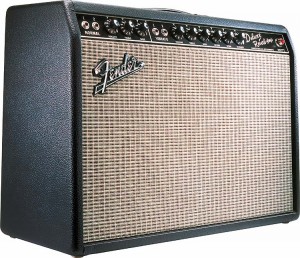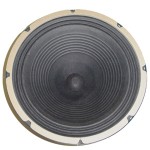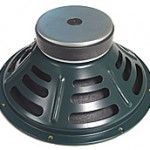 We’ve often discussed at LegendaryTones the fact that your tone can often only be as strong as its weakest link. With amplifiers themselves, often the weakest link turns out to be the speaker used. When thinking about the individual cost of the speakers and comparing that with the other individual components that make up an amplifier, speakers turn out to be one of, if not the most, expensive pieces used. So what does this often translate to for manufacturers looking to cut costs? You guessed it – throw in cheaper speakers.
We’ve often discussed at LegendaryTones the fact that your tone can often only be as strong as its weakest link. With amplifiers themselves, often the weakest link turns out to be the speaker used. When thinking about the individual cost of the speakers and comparing that with the other individual components that make up an amplifier, speakers turn out to be one of, if not the most, expensive pieces used. So what does this often translate to for manufacturers looking to cut costs? You guessed it – throw in cheaper speakers.
Take the greatest amp in the world and run it through the wrong/incorrect speakers and your tone will suffer no matter what you do – until of course you correct the problem directly and replace the speaker(s).
In playing a number of rigs over the years, I’ve personally learned that the speakers are often an under-appreciated yet critical element contributing to the final sound. Certainly other parts are important too and contribute to the final result in tone. But in many cases, a speaker swap can give you the largest bang for the buck when focusing on improving an amplifier.
Choosing the right speaker is a whole different issue altogether and takes a bit of research and may be an article we tackle in the future. For the time being however, our goal was to take a Fender Reissue amp of some type and upgrade it with a simple speaker swap and report the results. It has been our experience that the Fender Reissues generally have used marginal speakers at best. The Bassman LTD reissue we reviewed previously suffered greatly in our opinion due to the Jensen reissue P10R speakers (even though from a marketing standpoint, the P10R is the "right" speaker choice). The Jensen company of today is not the same company of yesteryear and let’s just leave that at that.
In today’s marketplace, smaller tube amps in the range of 20 watts or so are proving to be extremely popular. The Fender Deluxe Reverb is considered one of the company’s all-time best amplifiers. It’s small enough to be easily portable, can put out enough power to scream and distort quite a bit and sit on small stages, and it has all the classic Fender features such as reverb and tremolo. Being tube rectified, the Deluxe Reverb also can sag a bit and produce a very natural, and softer response when driven hard – a benefit to blues players in particular.
The reissue of the Deluxe Reverb has been out for some time and cosmetically is nearly identical to the original. It even uses the same polarity switch of the original even though it’s a useless feature since really the new amp has a polarized and grounded 3-prong AC cord. That aside, one has to appreciate the sense of authenticity of the amp cosmetically.
Fender describes its Deluxe Reverb in this way and offers these specifications:
"For rock, country or blues players that want a moderately powered amp they can crank up on the gig or in the studio. The fat, snappy guitar tones heard on many of our favorite recordings, from Memphis to Abbey Road, were made using the Deluxe."
- 22 watts into 8 Ohms
- Two 6V6 Groove Tube output tubes
- One 5AR4 rectifier tube
- Four 12AX7 preamp tubes
- Two 12AT7 tubes
- 1 x 12" 8 Ohm Jensen C-12K speaker
- Dual channels (Normal and Vibrato)
- Tube driven Fender Reverb
- Tube Vibrato
- Two-button footswitch for Reverb and Vibrato on/off
- Black textured vinyl with silver grille cloth
- 17.5" H x 24.5" W x 9.5" D, 42 lbs.
Inside the amp is a different story. Fender needs to meet a price point so a hand-wired version would obviously cost a quite a bit to build so the Deluxe Reverb is typical of most amps built today – it uses a printed circuit board (PCB) and has most of the pots and jacks directly mounted to the board. It’s a necessary step for mass production and cost reduction.
Going over to the tone of the Deluxe Reverb reissue, we can comment and state that the amp felt quite a bit more stiff and was also brighter than any of the various original units we’ve played. With that said, not all of the original vintage Deluxe Reverbs we tried were perfect either. One reason to replace a speaker could be for tonal improvement as an upgrade. Another reason could be of to replace a speaker that has severe problems or may be on its way to blowing out. We experienced this audibly with two out of the five original Deluxe Reverb amps we played (vintages varied from mid ‘60s blackface to very early ‘70s silver face models).
A small amp like a Deluxe Reverb can really sing when cranked, but the price to pay is more wear and tear on your speaker, and two of the bad-sounding examples clearly had problems with their low-end response and buzzed excessively.
The reissue didn’t have that problem in stock form – but it also didn’t have the fuller sound of some of the best originals – the top end of the reissue bites at you with frequencies that just don’t feel or sound good when cranked. It’s over the top in bright emphasis. The distortion pattern of the amp was also brittle and again with lots of top end was not very pleasing to the ear. Stating that the amp reminded us of a smaller version of the Bassman LTD in stock form (see previous review) would be a fair statement in my opinion. Now there aren’t many similarities between the Deluxe Reverb’s circuit and that of the Bassman and yet the output tone of both reissues was striking in sonic discomfort.
So with that, it was time to do the speaker swap. We chose to stick solely with the speaker change this time rather than perform other surgery and mods to the amp like we’ve done in the past since our goal was to have something easy and make it a quick bang for the buck. Changing is a speaker is one that most anyone could do themselves with minimal skill and tools.
The team at Weber have been producing various vintage and original speaker designs for years. They are not only the producers of speakers for amplifier enthusiasts, but they also manufacture speakers for OEM use as well.
I approached Ted Weber to ask for his opinion on the best speaker upgrade for the Deluxe Reverb reissue. He recommended the company’s 12F150 built with a "light dope".
Doping was a new term to me. Weber explains it like this:
"Doping is the shiny goop you see on the surround of a speaker. Besides extending the life of the surround, it also acts as a shock absorber to help keep the cone under control at higher volumes. The downside is that it also dampens cone vibrations and therefore reduces the potential character and texture of the speaker. If you are going to bend/sustain notes in the area above the 10th fret on the high E string and at high volumes with heavy distortion, then you need the doping to help prevent ghost notes and cone cry that could result from the extreme cone vibrations. Othewise, I would get the speaker undoped. Many players prefer the raw, undamped tone of the undoped speaker and they learn to modulate their finger pressure when noting in the area that causes cone cry."
Because we were looking to upgrade an amp that was going to see some heavy use, Weber’s recommendation for a light dope treatment seemed spot on as a happy medium between heavy use and maintenance of tone without other issues.
 The 12F150 is described as "Tweed Twin tone with ceramic punch," and is designed to be a direct replacement for the original Jensen (made in Chicago) C12N and Oxford ceramic 12 inch speakers. It uses a 40oz ceramic magnet, 1.5-inch voice coil and a ribbed-textured cone. The output can be selected at either 25 or 50 watts power capacity when ordering one from Weber, and impedance can also be specified for 4,8, or 16 ohms. For the Deluxe Reverb reissue, we went with the 25 watt version at 8 ohms.
The 12F150 is described as "Tweed Twin tone with ceramic punch," and is designed to be a direct replacement for the original Jensen (made in Chicago) C12N and Oxford ceramic 12 inch speakers. It uses a 40oz ceramic magnet, 1.5-inch voice coil and a ribbed-textured cone. The output can be selected at either 25 or 50 watts power capacity when ordering one from Weber, and impedance can also be specified for 4,8, or 16 ohms. For the Deluxe Reverb reissue, we went with the 25 watt version at 8 ohms.
The tone of the Deluxe Reverb did change quite a bit when we first tried the 12F150. It wasn’t as noticeable at first at lower volume settings, but became more apparent when we cranked up the amp. An immediate benefit is that I wasn’t reaching to knock down the treble control quite as intensely as I did with the original speaker, though make no mistake – the amp is going to be bright by design and there was still plenty of top end.
 However, the bottom end in the upper-low frequencies was more present, giving a warmer feel immediately that was pleasant. The overdrive was smoother – not as smooth as the original speakers found in some of the best of the original (and obviously much older) Deluxe Reverbs that had obviously some aging time to soften them up – but still noticeably better than the reissue’s original speaker.
However, the bottom end in the upper-low frequencies was more present, giving a warmer feel immediately that was pleasant. The overdrive was smoother – not as smooth as the original speakers found in some of the best of the original (and obviously much older) Deluxe Reverbs that had obviously some aging time to soften them up – but still noticeably better than the reissue’s original speaker.
A speaker can benefit from break-in time and various experts in the field we talked to stated that about 100 hours of use seems to be a good reference point. While we didn’t log in 100 hours with the speaker swap, the immediate results were encouraging. Added break-in time will soften the cone response and give an even smoother attack and note decay and after time there will even be some high-frequency roll off.
For the low upgrade price, the Weber 12F150 configured like our review sample is a great and easy way to get more tone out of your reissue Deluxe Reverb. Weber products can be found at www.webervst.com.